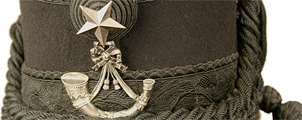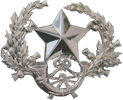Cameronians honoured in French town
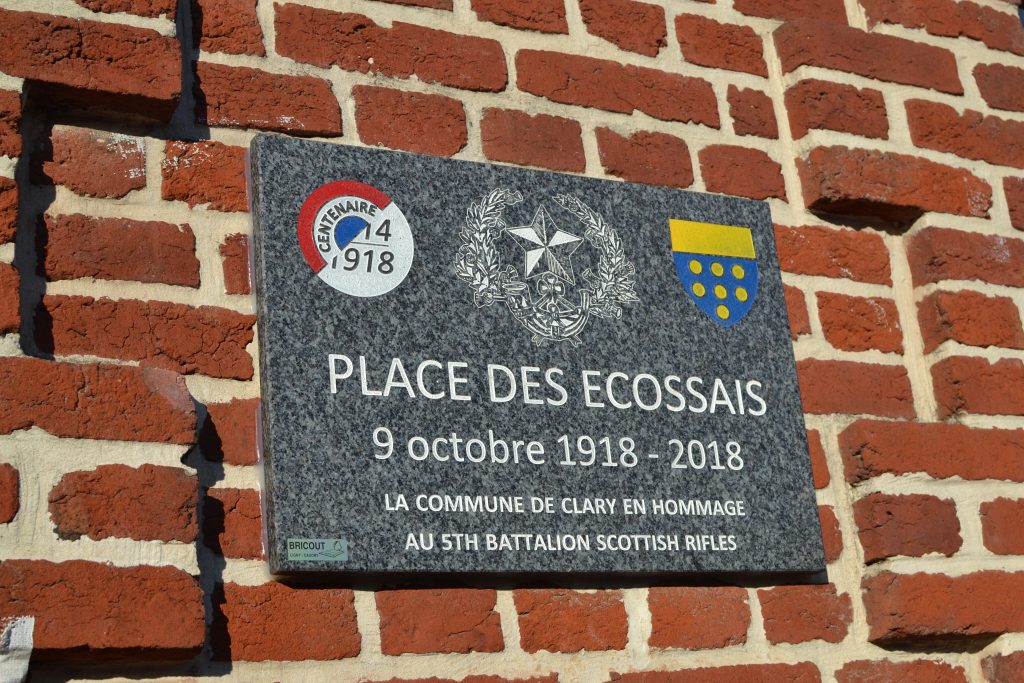
The new plaque unveiled in memory of the 5/6th Scottish Rifles at Clary
Last week I had the privilege of representing the museum service at a moving ceremony in the French town of Clary. Tuesday 9th October 2018 was the hundredth anniversary of the action in which the 5/6th Scottish Rifles liberated Clary from German occupation, bringing to an end years of hardship and oppression. Shortly after the Armistice, the residents of Clary had paid tribute to the 5/6th Scottish Rifles and renamed the town square Place des Ecossais in honour of the Scottish troops who had won them their freedom.
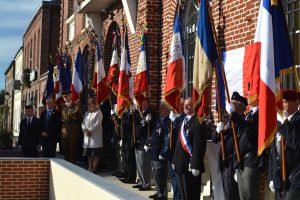
French veterans and standard bearers act as guard of honour to the unveiling party
One hundred years on, the residents of Clary once again commemorated the soldiers who had fought and died to liberate their town in a poignant ceremony held in the town square. A handsome marble plaque was unveiled on the wall of the Town Hall and commemorative crosses were laid by local children in memory of the soldiers who died in the actions leading to the town’s liberation.
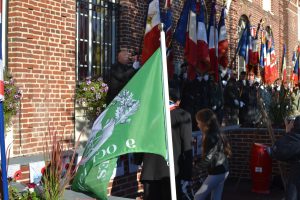
Local school children laying memorial crosses for those of The Cameronians (Scottish Rifles) who died on 9th October 1918
In a touching gesture of comradeship between Allies, the community of Clary presented me with a copy of the new plaque to display in Low Parks Museum. I’ll post more details about this over the next few weeks.
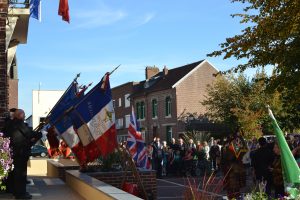
The standards dip as the crowd observe a moment’s silence in memory of those who gave their lives in the First World War
The genuine gratitude and sincerity expressed by the people of Clary in remembering The Cameronians was incredibly humbling and very moving to witness. What made the occasion even more special was the presence of the families of two members of the 5/6th Scottish Rifles who had fought at Clary in 1918. Several descendants of Colonel H. B. Spens D.S.O., who commanded the Battalion during the attack, were in attendance, including his grandson who was invited to assist in the unveiling of the commemorative plaque.
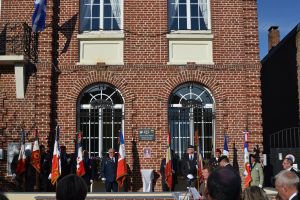
The newly unveiled plaque on the Town Hall of Clary. Under the plaque was placed a photograph of Colonel H. B. Spens, commanding officer of the 5/6th Scottish Rifles
Three relatives of Private Peter O’Hare, of Coatbridge, had traveled from Scotland to see their relative honoured. Peter O’Hare was one of the men who died in the action that led to the liberation of Clary. A number of other relatives of Private O’Hare held their own remembrance service at Coatbridge War Memorial in Scotland at the same time as the service was taking place in Clary.
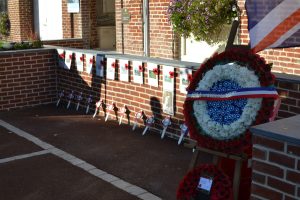
The wreath laid by the Mayor of Clary, the family of Private O’Hare, and Mr Adrian Smith on behalf of The Cameronians (SR) and Families Organisation. The wreath was made by the local school children
I have made several visits to the First World War battlefields of France and Belgium over the past twenty years, but seldom have I witnessed such a moving service and it is something I will never forget. Having seen firsthand how dedicated the people of Clary are in honouring the men of the 5/6th Scottish Rifles, it is safe to say that the memory of these men is in safe hands.
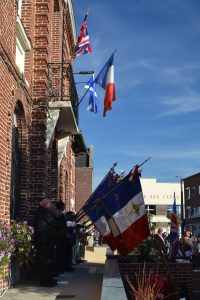
Comments:
The Religion of the Regiment in the Great War
Without question one of the most important topics which differentiates The Cameronians (Scottish Rifles) from other regiments is their association with the Church of Scotland and their many Presbyterian traditions. References in diaries and letters allude to the traditional posting of sentries which harks back to the regiment’s Covenanter roots. Nevertheless, to think of the regiment’s members as distinctly ‘hardcore’ Presbyterians would be to overlook the wide variety of recruits which came into the regiment during the First World War. While back in Scotland one newspaper remarked that a service for the Scottish dead from Gallipoli contained “grossly unscriptural and Popish prayer”[3], the men at the front covered a wide range of denominations. The religious denominations of the regiment do not seem to have been streamlined into one, modelling the regimental character as much as one which resembled the overall religious background of Scotland in the early twentieth century. Many Presbyterians, Roman Catholics, Anglicans, Atheists, and at least 85 Jewish soldiers are listed as having served in the regiment, with more not listing their true religion on enlistment forms.[4]
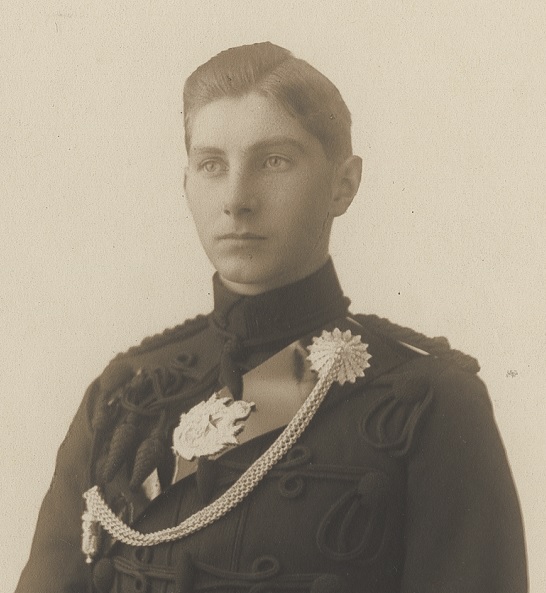
Lieutenant Charles ‘Frankie’ Rooke, a Jesuit, was the only Catholic officer of the 1st Battalion in 1914. He was killed on 19 June 1915 on a patrol near Bois Grenier.
At least one chaplain, Reverend James McShane attached to 19 Brigade (Including the 1st and 5/6th Battalions), was a Catholic Priest and would go on to be known through the pseudonym ‘Father McCabe’ in Robert Graves’ Goodbye to all that.[5] Company Sergeant-Major P. Docherty of the 5/6th Battalion described McShane as “idolised by men of every denomination who would have laid down their lives for him.”[6] Indeed Colonel Graham Chaplin, commander of the 1st Cameronians for much of the war found it extremely beneficial to have a Roman Catholic padre attached to a unit serving in a Catholic country such as France. While others had trouble bartering with the locals, McShane always managed to obtain chicken and eggs for the officer’s mess.[7]

Officers of the 1st Battalion, Cameronians (Scottish Rifles), and other regiments of the 33rd Division at the Divisional Horse Show at Cavillon, 18 July 1917. (© IWM Q 5693)
Whatever their religious background however, it was starkly evident that during everyday moments out of danger very few of the men preferred to identify with religion at all. Reverend John White, who, although assigned as a chaplain to the 5th Battalion, provided services to numerous others in 1915-16 perhaps had the best vantage point to decipher the religious devotion of the men. Callum Brown identifies this through the feeling of hopelessness and powerlessness felt by the average soldier, which chaplains interpreted as a growing connection to God.[8] However, this did not make them saints as White pointed out that;
The men enjoy a service that links them to their homes and firms up their ideals of life. I do not wish you to regard these men as stern puritans – they themselves would smile at the description – and if you think they are, you are sadly mistaken, and will, if you follow them from [church] parade, have a rude stick at some jest, or at some striking picturesque language, or it may be, you will suddenly lose sight of them as they drop into an estaminet.[9]
The church parades which the regiment attended when possible, were similar to those which had been conducted by chaplains throughout the history of the regiment, yet the reasoning behind many men’s attendance (at least those who willingly went) were mixed. One enlisted man in the 2nd battalion insisted that religious beliefs helped all ranks, and that a sermon received the day before entering the Battle of Festubert raised the morale of the whole battalion.[10] Another insisted solace found in religion was solely based on the individual upbringing of the soldier. In some cases the middle-class men would find solace in the religious traditions of the regiments, but many others claimed it was of no importance to them.[11] Callum Brown identifies that Scottish men as a population were declining in Church attendance, and that as part of a survey given to chaplains, only 20% of men in Scottish regiments had a “vital relationship” with the church.[12] The men who did choose to be religiously active outside of the mandated religious services found that there was a much more powerful spiritual experience to religion during the war. Sergeant Docherty watched as Padre McShane went around the entirety of 19 Brigade before their attack on High Wood on the Somme and called upon all Roman Catholics to attend a service:[13]
I am roman catholic myself, and it was the shortest and most impressive little service that I’ll ever attend. It is unforgettable and ever present in my mind. The shell-torn ground, Death Valley down below, the German shells landing intermittently on the road through the valley, and the whole Brigade looking on at about 300 men kneeling down to receive absolution before going into the battle from which the majority were fated never to return.[14]

Member of the 5th Scottish Rifles in graveyard, Spring of 1915. (Low Parks Museum CAM 2013.129)
[3] James Lachlan Macleod, “‘Greater Love Hath No Man Than This’: Scotland’s Conflicting Religious Responses to Death in the Great War,” Scottish Historical Review 81, no. 1 (April 2002): 95, doi:10.3366/shr.2002.81.1.70.
[4] Michael Adler and Max R. G. Freeman, British Jewry Book of Honour (Surrey St.: Caxton, 1922), 316-317.
[5] Robert Graves, Good-bye to all that (Anchor, 1929).
[6] Docherty, P., CSM. “5th Battalion Reminiscences Part II.” The Covenantor, Regimental Magazine of the Cameronians (Scottish Rifles), January 1936.
[7] Andrew Davidson, The Invisible Cross (London: Quercus, 2016), 288.
[8] Callum G. Brown, “Piety, Gender and War in Scotland in the 1910s,” in Scotland and the Great War, ed. Catriona Macdonald and E. W. McFarland (Edinburgh: John Donald, 1999), 180.
[9] John White, Rev., With the Cameronians (Scottish Rifles) in France: leaves from a chaplain’s diary (Glasgow: J. Smith, 1917), 57.
[10] Baynes., 203.
[11] Ibid
[12] Brown., 176.
[13] At the time 19 Brigade included the 1st Cameronians, 5th Scottish Rifles, 2nd Royal Welsh Fusiliers, and the 20th Royal Fusiliers.
[14] Docherty Part II.,
Comments:
Posted: 03/09/2018 by JamesTaub in First World War
Families and the Territorial Force
Tomorrow is the anniversary of the 7th and 8th Scottish Rifles’ attack on Gully Ravine on the Gallipoli peninsula. Based on cold statistics this was the worst single day The Cameronians (Scottish Rifles) suffered in the entirety of the First World War. While it would be many weeks for the scale of the losses to become known at home, we now know that between the two battalions over 470 men lost their lives in the attack. Not even in the opening phase of the Battle of Loos, in which many more battalions of the Regiment were engaged, would the casualties be matched. I don’t intend to go into the action at Gully Ravine in any great detail in this post; you can learn more about the 7th and 8th Battalions’ experience in that battle by reading my previous post marking the 100th anniversary. But this anniversary does provide an opportunity to remember the part played by the Territorial Force battalions of the Regiment as a whole, and the terrible losses felt by the communities these units represented.
The Territorial Force was created on 1 April 1908, the successor to the Volunteer Force of the mid-19th century. The men of the Territorial Force were ‘part time’ soldiers in that they remained in their civil employment but attended regular training weekends and drill nights where they were given a semblance of the training given to those soldiers of the Regular Army. Four battalions of the Territorial Force came under the parentage of The Cameronians (Scottish Rifles); the 5th, 6th, 7th and 8th Scottish Rifles. The 5th, 7th and 8th Battalions covered Glasgow, while the 6th Battalion belonged to Lanarkshire, and its headquarters were in Muirhall, Hamilton (now the site of Cameronian House – home of the Procurator Fiscal’s office and job centre). These battalions truly were microcosms of the areas they represented; the majority of men would live and work within the Battalion’s recruiting area, and many of the men would work together in the same businesses and industries. Many of the officers were drawn from the management and directorship levels of the companies and factories in which the men worked, while younger officers were often university students or graduates who had been attached to an Officer Training Corps. It was not uncommon for a private soldier or non commissioned officer of the Territorial Force to have their manager from their civilian occupation as a battalion officer.
One such example of this is Robert Downie of Hamilton; a draughtsman who was also a soldier of the 6th Scottish Rifles. In civilian life he worked in the offices of local architect Gavin Paterson, who also happened to be Lieutenant Colonel, commanding the 6th Scottish Rifles. Robert Downie did not survive the First World War. He went to France with the 6th Battalion in March 1915 as a sergeant and was awarded the Distinguished Conduct Medal for gallantry at Festubert, in June of that year. Downie was later commissioned and was also awarded the Military Cross for his actions when his battalion led the attack to push the German forces out of the French village of Clary, in late October 1918. Captain Robert Downie was killed on 6 November 1918, just five days before the Armistice.
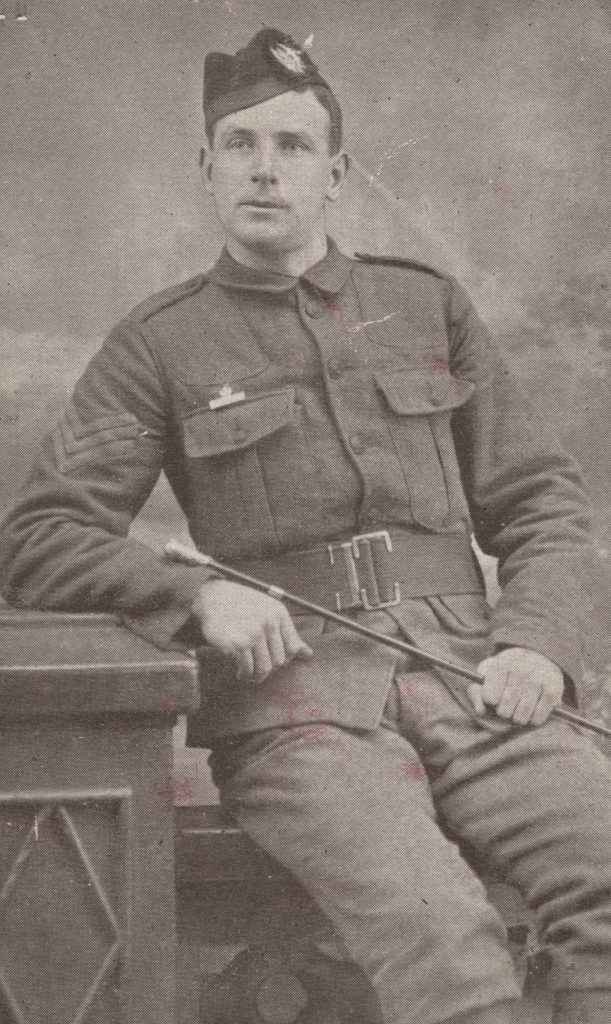
Sergeant Robert Downie, 6th Scottish Rifles
The Battle of Festubert, in which Robert Downie earned his DCM, was the first major engagement in which the 6th Scottish Rifles took part. The Battalion suffered heavy losses, which were closely felt by the towns and villages of Lanarkshire from which the men of the battalion called home. By their nature, Territorial Force battalions were far likelier to contain men from the same families as might be found in the Regular battalions of the Army. Brothers, brothers-in-law, cousins, and even fathers and sons were found serving together in the Territorial Force battalions. Searching through casualty notices in the Motherwell Times yesterday, I came across this particularly heart breaking letter:
Letter from Private James Dickson – to his parents in Motherwell
“I regret very much to tell you that Jamie Baird died yesterday afternoon at 2.30. I got word yesterday morning that he was lying in a hospital barge in a canal about an hour’s walk from where we are billeted, so I got a pass immediately after parade, and set out to see him. I just got to the barge when a sergeant of the R.A.M.C. came down the gangway, so I asked if I could see Sergt. Baird, as he was a brother-in-law of mine, He had a slip of paper in his hand, and he showed me it with Jamie’s name on it, and said that if I had been ten minutes sooner I would have seen him pass away. He told me he died very peacefully, and I went on and saw him lying where he died. He was quite warm, and looked very nice. I asked what the nature of his wounds were. He told me he had one in the abdomen and one on the hand. I asked when he would be buried, so they sent me to another place further on and they told me there that he would be buried at six o’clock, so I hurried off to our billet and got a party of our company, and we laid him to rest in a nice little graveyard in a village which I can’t give you the name of just now, as we are not allowed to do so. Just break the news as gently as possible to poor Annie (Mrs Baird). I am heart sorry for her, and all my little nieces and nephews. They will miss their father, but he fell fighting and was brave to the last, although that is very little consolation to those who are left behind. I asked the ambulance sergeant major if he would put up a little cross and he promised to do so, and they told me that all the articles that were his would be sent to the base and then on to his wife.”
James Baird was married to Annie Dickson, Private James Dickson’s sister. James and Annie had seven children – the ‘little nieces and nephews’ mentioned in Private Dickson’s letter.
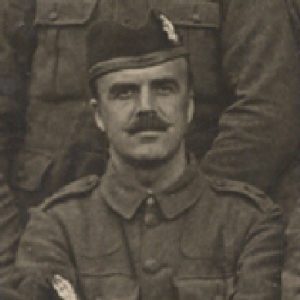
Sergeant James Baird, 6th Scottish Rifles
Two brothers from Motherwell, Robert and Isaac Devon, were also serving in the 6th Scottish Rifles during the Battle of Festubert. Isaac, who was soldier-servant to Captain Lusk, was wounded but survived, while Robert was wounded and died the following day.
Looking back to Gully Ravine, many families from Glasgow suffered multiple blows when the full extent of the losses among the 7th and 8th Battalions became known. A chilling newspaper article in the Daily Record of 27 July 1915 lists a number of casualties from the 8th Scottish Rifles. Printed at the head of the list is an appeal from one mother looking for information on her sons:
“Mrs. Annie Murdoch, 117 Alexandra Parade, has received intimation from Territorial Force Headquarters at Hamilton that her three sons – Gavin (21), Ronald (19), and William (17) – all in the 1/8th Cameronians, have been missing since 28th June. All three were in H Company.
Mrs. Murdoch has other two sons serving King and country – Norman (25) who is an electrical engineer in the Transport Department now in Flanders, and Hugh (15) in the Royal Navy, now on his way to the Dardanelles. Mrs. Murdoch will be glad to hear any tiding of her three missing sons.”
I could find no further mention of the Murdoch brothers in subsequent editions, however the Commonwealth War Graves Commission online register does record the names of a Gavin Murdoch, Ronald Murdoch, and William Murdoch, all having died on 28 June 1915 serving with the 8th Scottish Rifles. All three men are commemorated on the Helles Memorial, suggesting their remains were never identified. There are no obvious commemorative records for Hugh or Norman Murdoch, so one can hope that they at least returned safely to their mother in Glasgow at the Wars end.
This photograph shows the officers of the 8th Scottish Rifles, taken in late 1914.
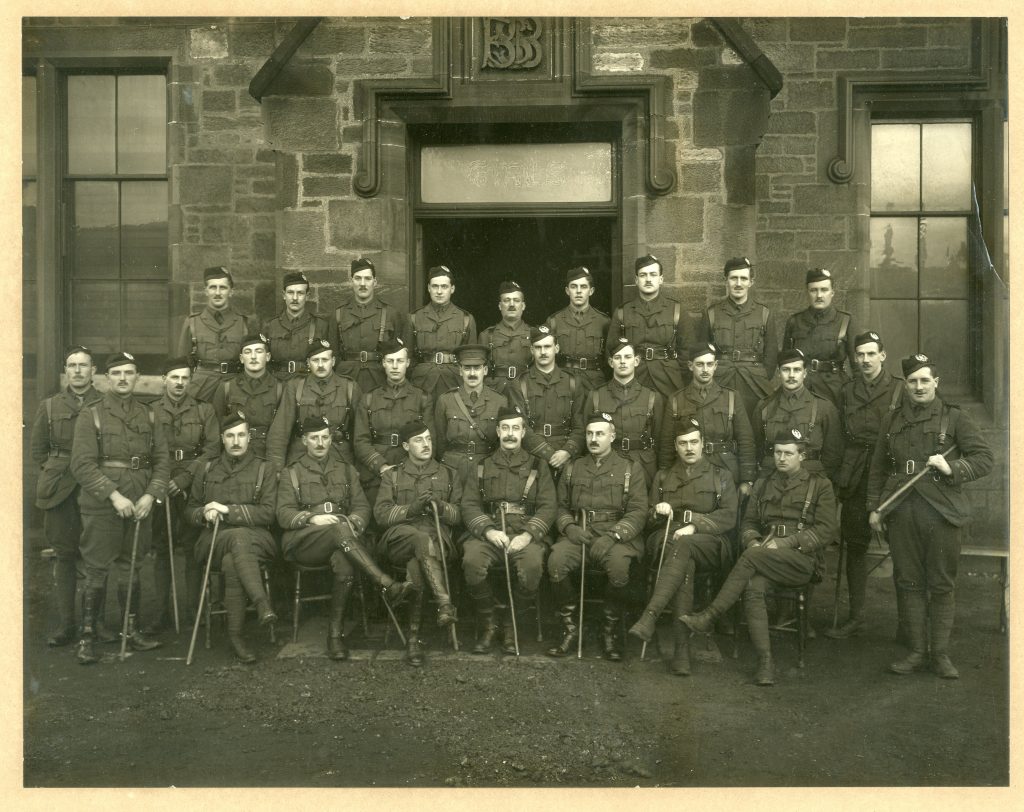
Rear row, left to right: Lt E. Maclay*, 2Lt R. Humble, Lt J. T. Findlay*, Lt W. N. Sloan, Lt & QM H. Bowen*, 2Lt T. Stout*, 2Lt A. R. Tillie*, 2Lt W. S. Maclay*, Lt G. H. Crichton, Middle Row: 2Lt D. S. Carson, Capt C. J. C. Mowat*, 2Lt T. L. Tillie, Lt H. McCowan*, Captain W. C. Church*, Capt A. B. Sloan (RAMC), Capt H. A. MacLehose, Lt R. C. B. Macindoe*, Lt G. A. C. Moore*, Lt A. D. Templeton*, 2Lt J. W. Scott*, Capt E. T. Young*, Front row: Capt W. T. Law, Capt J. W. H. Pattison, Major R. N. Coulson, Major J. M. Findlay, Lt-Col H. M. Hannan*, Capt C. G. Bramwell*, Capt J. M. Boyd, Capt C. A. D. Macindoe* (* denotes died or killed in the War)
A few months after this photograph was taken, the Battalion would depart for Gallipoli. Of the 29 men shown in this photograph, 17 would never return home. Eleven of those were killed or died in the action at Gully Ravine on 28 June 1915. There are two pairs of brothers in this photograph; the Tillies and the Maclays, all young Second-Lieutenants. Two of the officers shown were also cousins; Lieutenant R. C. B. Macindoe and Captain C. A. D. Macindoe.
Talbot Lee Tillie was badly wounded on 28 June – his life was saved by one of his Sergeants, Stephen Miller, who risked his own life to drag the wounded officer back to the relative safety of the British lines. Arnold Reed Tillie did not survive the War. He had transferred to the Royal Flying Corps and was killed on 11 May 1916. A third Tillie brother, John Archibald, died on 19 July 1918, serving with the Black Watch.
William Strang Maclay died on 25 June 1915, in the lead up to the attack on Gully Ravine. His brother, Ebenezer, survived Gully Ravine, and a subsequent attack launched by the survivors of the 7th and 8th Scottish Rifles on 12 July 1915. Ebenezer was invalided home to the UK in August 1915, and subsequently transferred to the Scots Guards, with whom he was serving when he was killed on 11 April 1918.
Cecil and Ronald Macindoe, cousins, were both killed on 28 June at Gully Ravine.
Two of the officers pictured had also represented Scotland in Rugby; Captain W. C. Church, and Captain E. T. Young. Captain Church’s name is soon to be added to a new panel in the University of Glasgow Memorial Chapel, commemorating 19 men previously missing from the University’s roll of honour.
I can think of few other photographs that demonstrate the human cost of the War as clearly as this. The details listed above are, of course, just a few individual stories from the thousands that make up the Regiment’s losses in the First World War, but for me, they exemplify the particularly high price paid by all Territorial Force battalions of The Cameronians (Scottish Rifles).
Comments:
ID’ing Your Cameronian 1914-18
One of the identifying features of a British soldier is the various insignia and trappings of their regiment. The Cameronians (Scottish Rifles) are no exception to this. On service during the First World War, members of the regiment wore a uniform and used kit the same as other soldiers of the British Army, yet as we’ll see they retained certain regimental distinctions which can help you identify a Cameronian in a crowd.
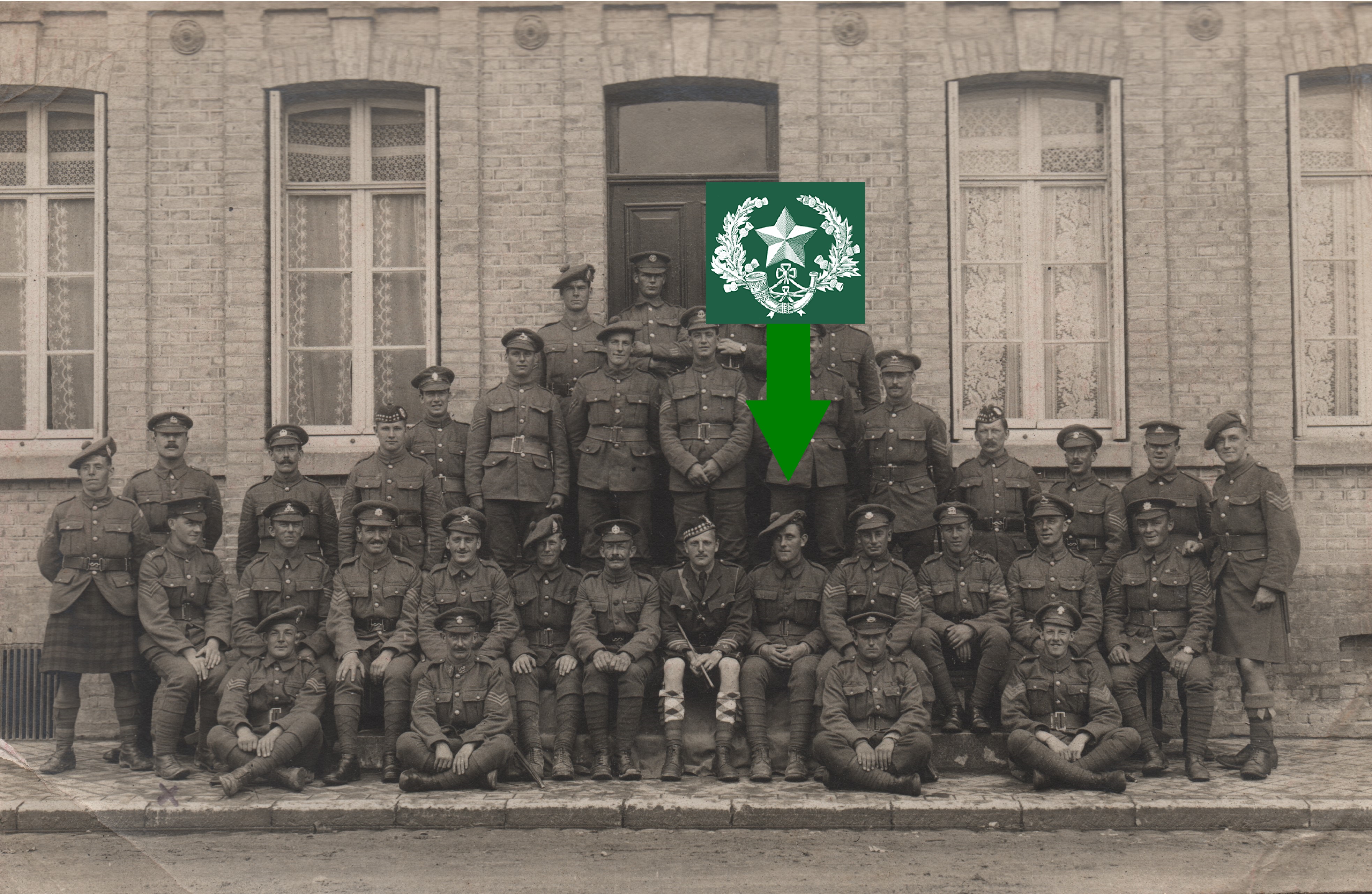
4th Army School in France. Can you tell which one of these soldiers is a Cameronian? (Photo Courtesy of James Taub)
THE UNIFORM
Like other soldiers of the British Army when in the field the Cameronians (Scottish Rifles) wore a khaki coloured wool uniform. Officially referred to as the 1907 Service Dress uniform. It consisted of trousers and a tunic. The tunic includes much of what you need to identify a Great War serviceman as a member of the Cameronians (Scottish Rifles).
Black Buttons- As a rifle regiment, the Cameronians (Scottish Rifles) were allowed the distinct honour of wearing blackened horn buttons. While on their rifle green dress uniform, they would sport buttons with a horn and thistles distinct to the regiment, during the Great War the buttons worn on service dress were the standard blackened horn button issued to all rifle regiments.
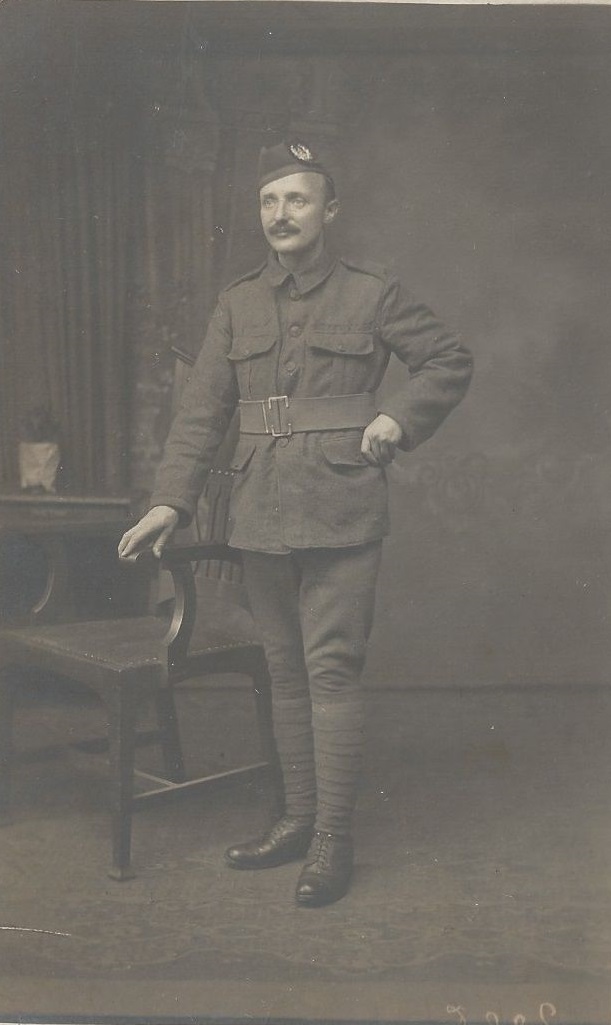
A Cameronian wearing the standard 1907 Service Dress uniform. He is sporting the regiment’s black buttons and shoulder titles. (Courtesy of James Taub)
Shoulder Titles- Although there was still conflict between the 1st and 2nd Battalions at the outbreak of the First World War regarding being called ‘Cameronians’ or ‘Scottish Rifles’, all soldiers of the regiment were issued with brass “SR” shoulder titles. These would be blackened (generally with boot polish) to acknowledge the soldier’s status as a member of a rifle regiment.
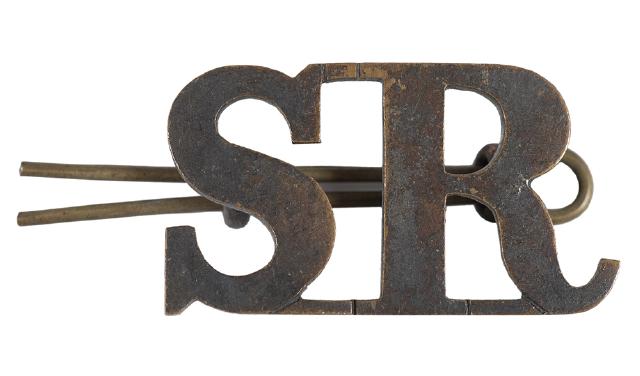
First World War SR shoulder title. (CAM 2007.39.3)
HEADWARE
The hats and helmets of the regiment would change as the war progressed. As part of the dress uniform and the initial 1914-15 uniform, soldiers would be wearing the traditional rifle green glengarry with the regimental badge. In mid-1915, a small bonnet was introduced. By early 1916 the tam o’shanter was making its appearance for wear behind the lines. Simultaneously brodie helmets were introduced for front-line wear.
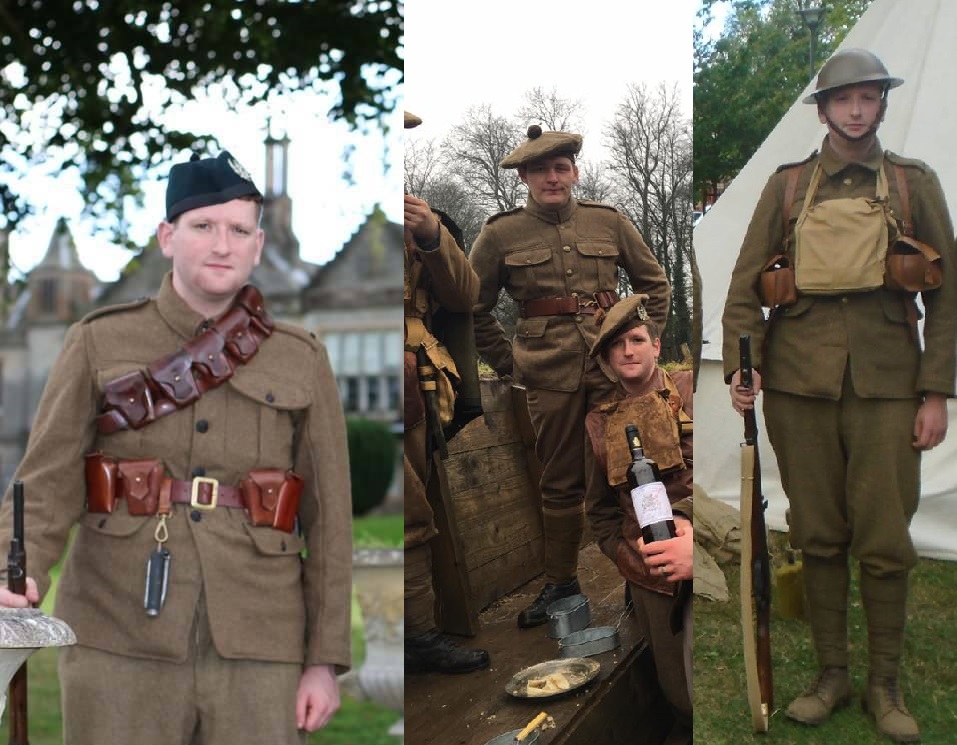
Reenactors donning the glengarry, tam o’shanter, and helmet. The three main pieces of headgear for the Cameronians (Scottish Rifles) in the First World War.
Comments:
For Bravery in the Field – a follow up
Yesterday I wrote about the men of the 10th Scottish Rifles who went on a patrol into no man’s land on 21st December 1917. Sergeant John Wilson, from Hamilton, was one of the two men who returned to the British lines three days later, on Christmas Eve.
This morning I found some additional information that sheds some light on what happened to the brave Sergeant in the years following the First World War.
While searching through online newspaper articles, I came across an account in The Scotsman of King George and Queen Elizabeth’s Royal visit to Lanarkshire on 4th May 1938. The article recounted that, following a reception at Hamilton Town House, Their Majesties were making their way to their car when they observed in the crowd, a group of 14 men wearing medals. The King enquired who the men were, and was introduced to them by the Provost. The men were all limbless ex-servicemen from the area, and among them was none other than Sergeant John Wilson MM:
Mr Dodd [the leader of the group of ex-servicemen] drew His Majesty’s attention to John Wilson, holder of the Military Medal, who lost both his legs while serving in France. “How do you manage to get along?” inquired His Majesty, and Mr Wilson modestly replied. “Oh, fine.”
I then started looking through the regimental magazine of The Cameronians (Scottish Rifles), titled The Covenanter, and found an obituary notice for John Wilson, published in the January 1945 edition. It reads:
Death of Old Cameronian
We Regret to Record the death of Mr John Wilson, a linotype operator on the staff of “The Hamilton Advertiser” for over 35 years. Mr Wilson served as a non-commissioned officer in the Great War with the 6th Battalion The Cameronians (Scottish Rifles). He was twice wounded, once at Festubert and again in 1918 in an action in which he was awarded the Military Medal. He lost one of his fingers at Festubert. In 1918, he received a severe gunshot wound and suffered severely from frost-bite through forced to remain in “no-man’s-land” for three days. He had both legs amputated below the knee as a result of this experience. Following his discharge from the Forces, he returned to his civilian occupation and, because of his disability, was trained as a linotype operator. Even with two artificial legs he was very agile and served the firm faithfully and well up till the time of his death. There is no doubt that his general health suffered as a result of his war service, but “Jock”, as he was familiarly called, bore his illness with true Cameronian fortitude and was never heard to utter one word of complaint. Mr Wilson was one of the pioneers in the formation of Hamilton and District Branch of the British Limbless Ex-Servicemen’s Association, and was also an enthusiastic member of the Regimental Association of The Cameronians (Scottish Rifles). “Jock” also took a keen interest in “The Covenanter”, and in his capacity as a linotype operator he was given the job of setting-up the type for the magazine. This afforded him a great deal of pleasure and kept him very much in touch with the activities of his old Regiment. At the funeral to Bent Cemetery, Hamilton, his old Battalion was represented by the presence of its honorary colonel, Lieut. Col. J. C. E. Hay, C.B.E., M.C., T.D., D.L.
Further notifications in The Covenanter reveal that John Wilson bequeathed his medals to The Cameronians (Scottish Rifles) regimental museum, and also bequeathed a sum of money to the Regimental Museum Fund.
South Lanarkshire Council’s Bereavement Services were very helpful when I made enquiries about the whereabouts of Sergeant Wilson’s grave, and armed with plot details and a map I made my way there to pay my respects. It would appear, however, that Sergeant Wilson’s grave lies unmarked; perhaps not surprising as his obituary notice made no mention of any surviving family who might have arranged a headstone. I placed a memorial cross in a tree as near as I could estimate where Sergeant Wilson’s grave might lie.
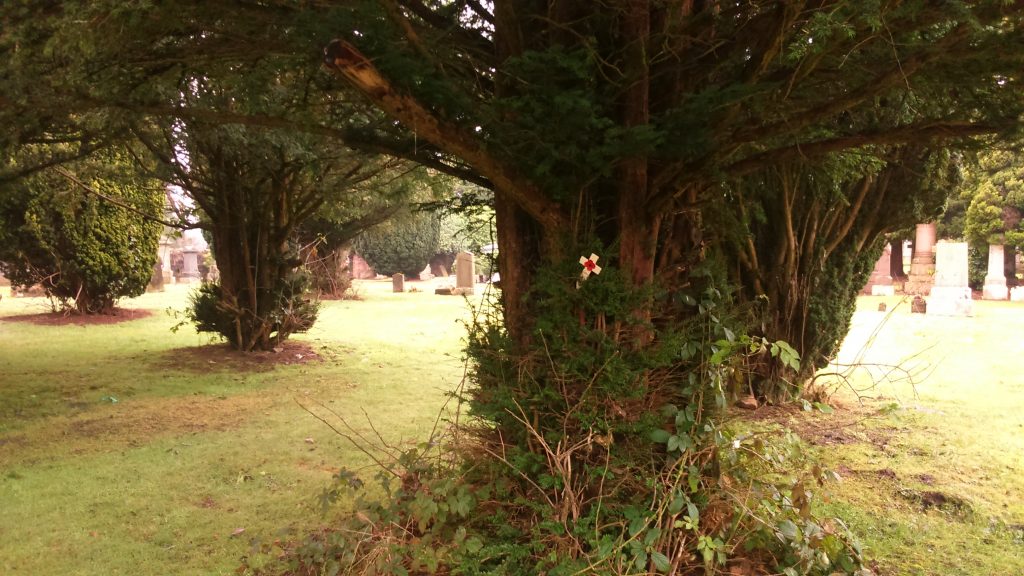
On Christmas Day, safe and warm and in the company of my family, I’ll raise a glass and spare a thought for Lieutenant Ewen, Lance Corporal Thomson, Private Aberdeen, and of course, Sergeant John Wilson, and what they went through in no man’s land 100 years ago.
Comments:
Log in




